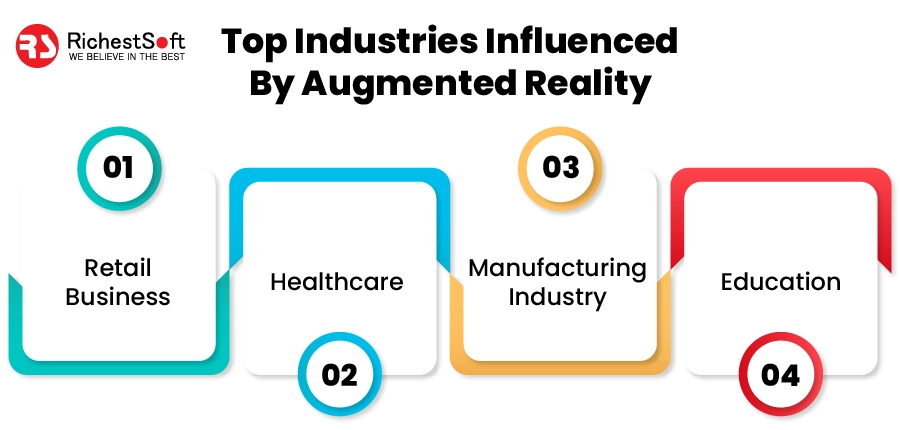Introduction
By blending the virtual and physical worlds, augmented reality is growing as a paradigm-shifting technology that improves our awareness of and engagement with the environment. In 2023, AR expanded to previously unheard-of levels, with several sectors of commerce and industry realizing its potential for development and innovation. The background and development of augmented reality scope, its present application, and potential future growth are all covered in this article.
The promise of augmented reality scope has grown beyond the idea stage, and it is now recognized as a game-changing technology. By providing new and creative methods for businesses to communicate with consumers, improve efficiency, and spur development, augmented reality (AR) is set to disrupt several sectors in 2023 and beyond.
As technology, programs, and the combination with new technologies progress, augmented reality will change how we live daily by fusing the real and virtual worlds.
What is the Meaning of Augmented Reality? What Applications Will Augmented Reality Have in 2023?
The term “augmented reality” describes integrating digital data or simulated items into the physical environment to improve the user experience. With AR, users can communicate with the actual world and the virtual parts instead of simulated reality, which involves users in a simulation. Numerous industries – playing games, entertainment, learning, medical care, production, and advertising, have benefited from the increased use of this technology.
Scope of AR in 2023
In 2023, the augmented reality scope has expanded significantly, and its potential for various industries is becoming more evident. Applications for augmented reality in gaming, entertainment, medical care, industry, and promotion are available. Its adaptability and capacity to improve customer service have provided it with a technology that both companies and consumers want to adopt.
By 2023, augmented reality’s application will have significantly increased. According to market research, the AR industry will expand quickly and surpass 70 billion dollars by 2023. The growing use of AR in sectors including production, healthcare, and retailing is the primary driver of this rise.
- The retail business might be transformed by augmented reality scope. With AR, customers can visualize products in their spaces before purchasing, enhancing customer engagement and increasing sales. In healthcare, AR technology transforms medical training, surgical procedures, and patient care by providing real-time information and guidance to healthcare professionals. In manufacturing, AR is utilized for assembly line processes, maintenance, and quality control, improving efficiency and reducing errors.
- In healthcare, the scope of augmented reality in 2023 is vast. AR technology is transforming medical training, allowing healthcare professionals to practice procedures in a virtual environment, improving their skills, and reducing the risk associated with real-time surgeries. Surgeons can also benefit from AR guidance during complex strategies, with real-time vital information overlays, enhancing precision and patient safety.
- The manufacturing industry is another sector where augmented reality has made significant strides. In 2023, AR will be used for assembly line processes, maintenance tasks, and quality control. By overlaying digital instructions or highlighting components in real-time, AR enhances efficiency and reduces errors, improving productivity and cost savings.
- Moreover, the Augmented reality scope in 2023 extends to education. AR is increasingly integrated into curricula to provide students with immersive and interactive learning experiences. It allows them to visualize complex concepts, interact with virtual objects, and engage in simulated environments, fostering better understanding and retention of information.
Furthermore, augmented reality scope has become a powerful tool in marketing and advertising. Businesses leverage AR to create interactive campaigns, allowing customers to engage with products or services in novel ways. Interactive product demos, 360-degree tours, or gamified events are just a few AR-driven marketing tactics that may draw people in and spread the word about the company.
What is the Background of Augmented Reality? Where did it Originate?
For some time, people have been debating the idea of augmented reality. Ivan Sutherland invented the contemporary “Sword of Damocles,” another head-mounted virtual reality program that launched AR. However, Tom Caudell, an investigator at Boeing, did not coin the word “AR” until the 1990s, when it began to get considerable attention.
- Early on, military and commercial uses of augmented reality consisted of instruction and simulations for flying airplanes.
- The practicality of combining AR (augmented reality) into various businesses has increased with the maturity of technological devices, software, and graphics for computers. Popular technology businesses like Microsoft and Apple have effortlessly incorporated augmented reality (AR) aspects into their goods and operating systems in recognition of the internet’s enormous potential.
- Programmers now have access to the required frameworks and tools to create real-time augmented reality programs and apps thanks to the development of augmented reality software kits like the company’s ARKit and the search engine’s ARCore targeting iOS devices.
These application kits offer programmers comprehensive resources to create compelling AR experiences.
- Computer vision, monitoring, and mobile device advancements have eased the creation and adoption of augmented reality (AR).
- With uses spanning from gaming and leisure to education, health care, and more, augmented reality is looking forward to becoming ever more absorbing, effortless, and interwoven into everyday activities as technology advances.
The technology developed in the following years and main improvements were achieved. The release of the first smartphone virtual world usage, “Layar,” in 2009 was a watershed moment in the evolution of AR. After then, well-known technology companies such as Apple and Google began to embrace AR and incorporated it into their software and hardware platforms.
What Future Applications Will Augmented Reality Have?
Market Growth:
Augmented reality is equitable for significant growth and expansion in the coming years. The AR market is estimated to witness substantial market value and penetration across industries. This optimistic outlook is driven by technological advancements, increasing consumer awareness and demand, and a surge in AR research and development investment. With a projected compound annual growth rate of 60.55%, the augmented reality scope market is on track to exceed $151.93 billion by 2024.
Industry Adoption:
Many industries increasingly embrace and adopt augmented reality, recognizing its transformative potential. In the years ahead, we anticipate a rapid adoption and integration of AR solutions across sectors, including retail, healthcare, manufacturing, education, and marketing. Businesses are actively exploring the applications of AR and harnessing its capabilities to gain a competitive edge and elevate customer experiences.
Retail Experiences:
Augmented reality is set to revolutionize the retail sector, reshaping the shopping experience profoundly. Customers can expect enriched and personalized experiences through AR-driven solutions in the coming years. Virtual try-on experiences for clothing, footwear, and accessories will become more sophisticated, enabling customers to see virtually how items look on them before purchasing. Virtual showrooms and fitting rooms will empower consumers to visualize furniture and home decor in their separate spaces, facilitating better decision-making and reducing product returns. Moreover, integrating AR with e-commerce platforms will blur the boundaries between online and offline shopping, resulting in seamless and immersive experiences for customers.
Healthcare Innovations:
The augmented reality scope in healthcare is vast and holds tremendous promise. AR will keep transforming patient care, surgical techniques, and medical education in the years ahead. Using layering containing patient data, anatomic details, and operational instructions, real-time augmented reality (AR) assistance will help surgeons perform complex procedures with greater precision, lower risk, and superior patient results.
AR will also find utility in medical education, allowing students and professionals to visualize intricate medical concepts, simulate surgeries, and engage in virtual environments. Telemedicine will be elevated through AR, enabling remote consultations, diagnoses, and treatment planning.
Manufacturing Advancements:
Augmented reality is poised to transform manufacturing processes and drive productivity improvements. By overlaying digital instructions and real-time data onto physical objects, AR empowers workers to execute complex assembly tasks with heightened efficiency and accuracy. AR can provide step-by-step guidance, highlight potential errors, and streamline quality control processes. Maintenance and repair procedures can be enhanced through AR overlays, ensuring timely and precise execution. Additionally, AR-powered training modules can equip workers with the requisite skills and knowledge to operate machinery and perform tasks effectively.
Education and Training:
The augmented reality scope in education and training will continue to expand in the years ahead. AR offers immersive and interactive learning experiences, enabling students to visualize abstract concepts, interact with virtual objects, and partake in simulated environments. This technology promotes active learning, increases student involvement, and strengthens knowledge retention. The seamless integration of AR into various academic fields, such as engineering, science, the past, and the arts, can help students get deeper comprehension and enjoyment of the material.
Marketing and Advertising:
Augmented reality is a potent tool in marketing and advertising campaigns. In the coming years, businesses will leverage AR to create interactive and captivating consumer experiences. Virtual try-on experiences for cosmetics, fashion, and accessories will attain higher levels of sophistication and realism.
AR-driven product demonstrations will enable customers to engage with virtual representations of products, exploring their features and benefits in an immersive manner. Gamified AR experiences will captivate consumers, cultivating brand loyalty and driving sales. Marketers will harness the immersive and interactive nature of AR to deliver memorable and impactful brand experiences.
Integration with Emerging Technologies:
By combining augmented reality with other advanced-level technologies, its application potential can be further increased. The development of AR applications will depend on artificial intelligence (AI).
AI algorithms will improve object recognition, optimize tracking, and enable more realistic and intelligent interactions within AR environments. Integration with the Internet of Things (IoT) will facilitate seamless connectivity between physical and digital realms, giving rise to innovative augmented reality experiences in domains such as smart homes, smart cities, and industrial IoT applications. The convergence of AR, AI, and IoT will unlock novel possibilities for personalized and context-aware AR experiences.
In summary:
The scope of augmented reality in the coming years is extensive, holding immense potential across diverse industries. With projected market growth, increasing industry adoption, and ongoing technological advancements, AR is primed to revolutionize how we shop, learn, receive healthcare, manufacture goods, and engage with brands. Integrating AR with emerging technologies will pave the way for innovative, immersive, personalized, and intelligent experiences, benefiting individuals and businesses.
How are Businesses Planning the Future of AR?
Businesses at the forefront of innovation are eagerly planning for the future of augmented reality (AR), recognizing its incredible potential to revolutionize customer experiences, streamline operations, and open up new avenues for revenue generation. With a keen eye on the horizon, these visionary companies are actively charting their course to integrate AR into their business strategies –
- One of the primary drivers of this preparation is extensive research and development (R&D) initiatives. Businesses across various industries are investing significant resources to explore the limitless applications of AR within their specific domains.
- Collaborating with technology firms, AR specialists, and research institutions, they are delving into the possibilities and forging innovative solutions tailored to their unique needs. By staying at the forefront of AR advancements, these companies are dignified to leverage this transformative technology effectively.
- Strategic partnerships are also a crucial aspect of shaping the future of AR. Businesses are joining forces with AR technology providers, content creators, and platform developers to tap into the specialized expertise and resources required for successful AR integration. These collaborations foster the development of cutting-edge AR solutions and expedite their seamless integration into existing workflows and systems.
Successful businesses understand that AR must be customer-centric, aligning with their target audience’s needs, preferences, and pain points. To this end, they invest in thorough customer research, gaining deep insights into what truly matters to their customers. This customer-centric approach enables businesses to create AR applications that address real problems, deliver personalized interactions, and foster long-lasting engagement and loyalty.
- User interface (UI) and user experience (UX) design are pivotal in the AR strategies of forward-thinking businesses. They recognize that intuitive and seamless AR interactions are essential for widespread adoption. Collaborating closely with AR specialists, design teams are tasked with crafting visually captivating, immersive, and user-friendly interfaces that guarantee customers a smooth and enjoyable AR experience. By prioritizing UI/UX design, businesses ensure that their AR applications leave a lasting impression.
- Pilot projects and proof of concept (POCs) are invaluable for businesses as they test the viability and effectiveness of their AR applications. These initiatives provide valuable insights, allowing companies to gauge performance, identify challenges, and refine their strategies accordingly. By initially implementing AR on a smaller scale, businesses can fine-tune their approaches before scaling up to larger deployments, ensuring more seamless integration and optimal outcomes.
Recognizing the need for a skilled workforce, businesses invest in training programs to equip their employees with the necessary capabilities to harness AR’s power effectively. They acknowledge that AR demands a unique skill set encompassing content creation, 3D modeling, AR app development, and data analysis. By fostering a continuous learning and upskilling culture, businesses ensure their workforce is prepared to embrace AR and drive innovation within their organizations.
- Integration with existing systems is a critical consideration for businesses planning the future of AR. They evaluate the compatibility of AR solutions with their enterprise resource planning (ERP) systems, customer relationship management (CRM) platforms, and other core infrastructures. Data management, security, scalability, and interoperability are carefully assessed to ensure a seamless fusion of AR with existing operations.
- Leveraging data analytics and deriving meaningful insights from user interactions and behavior is a crucial focus for businesses leveraging AR. They explore ways to capture and analyze the data generated through AR applications, uncovering valuable information about user preferences, purchasing patterns, and engagement levels. With these insights, businesses can refine their AR strategies, deliver more personalized experiences, and foster stronger customer connections.
- Regulatory and ethical considerations also feature prominently in the planning of AR integration. As AR becomes more pervasive, businesses proactively assess privacy, security, and ethical guidelines to ensure responsible implementation. By adhering to industry standards and best practices, these businesses build trust with their customers, safeguarding their privacy while reaping the benefits of AR technology.
In conclusion:
Businesses planning for the future of augmented reality are adopting a strategic and customer-centric approach. They invest in research, form strategic partnerships, prioritize user experience design, conduct pilot projects, and provide comprehensive training and skill development. Integration with existing systems, data analytics, and adherence to regulatory and ethical standards are crucial aspects of their planning. By embracing AR and laying the groundwork for its future, these businesses position themselves to unlock the full potential of this transformative technology.
Top Technology Trends of Augmented Reality in 2023
Artificial Intelligence (AI) Integration:
In 2023, one of the top technology trends in augmented reality scope is the integration of artificial intelligence (AI). AI and machine learning algorithms are incorporated into AR systems to enhance object recognition, tracking, and interaction. This integration enables more realistic and interactive AR experiences by enabling the system to understand and interpret the surrounding environment more accurately.
AI makes AR work much better:
Augmented reality (AR) and artificial intelligence (AI) are distinct technologies that, when combined, showcase a remarkable synergy. The intricacies involved in AR, such as interpreting sensor data from the environment, necessitate sophisticated algorithms. In this regard, AI is an invaluable tool by simplifying and enhancing the process, surpassing what a human model could achieve alone. The integration of AI in AR empowers the technology to provide more accurate and immersive experiences for users, pushing the boundaries of what is possible in the realm of augmented reality.
Metaverse Development:
The idea of the Metaverse, an online universe where users may communicate with other individuals in an artificially created setting, is gaining popularity. Users can smoothly switch between the actual and virtual worlds thanks to augmented reality, which is looking forward to playing a significant part in defining the Metaverse.
In the coming years, we can anticipate the development and expansion of metaverse platforms that leverage AR technology to create immersive and interconnected virtual experiences.
Some metaverse developments of augmented reality scope are:
Web AR:
Another significant trend in augmented reality is the rise of web-based AR. This technology allows users to access AR experiences directly through web browsers, eliminating the need for dedicated applications. Broader availability, simplicity of dissemination, and compatibility with various platforms and devices are just a few benefits of web augmented reality. As web virtual reality technology develops, we may anticipate a rise in web-based augmented reality apps, from marketing efforts to instructional resources.
Mobile Augmented Reality:
The widespread adoption of smartphones has fueled the growth of mobile augmented reality. With AR capabilities integrated into mobile devices, users can experience AR on the go. Location-based AR experiences, game programs, and dynamic navigational devices are just a few of the numerous possibilities that mobile AR may provide. Mobile AR is expected to become increasingly popular and significant over the next several years as smartphones become more potent and augmented realities grow more advanced.
It includes-
Geospatial API for ARcore. It allows developers to design experiences linked to certain astronomical places. AR encounters in the past have only been related to the person using them or in random places chosen by the user.
ARKit 6 enhancements. At WWDC in 2022, Apple unveiled several new capabilities for its ARKit 6 update. One involves capturing a 4K video when ARKit material is being used. Scene shadowing and other encounters are now considerably more realistic thanks to an improvement to the depth API. With Apple’s LiDAR scanners, AR experiences may be created so rapidly that the technique is called “instant AR.”
Augmented Reality in Retail:
The retail industry is experiencing a significant transformation with the integration of augmented reality. AR is revolutionizing how consumers shop by offering virtual try-on experiences, personalized product recommendations, and interactive shopping interfaces. Customers can now visualize how clothing, accessories, or furniture will look in real-time, enhancing decision-making and reducing product returns.
Retailers leverage AR to provide unique and engaging experiences that differentiate them from their competitors. We can expect further advancements in AR retail applications, such as virtual showrooms, augmented reality-powered advertising campaigns, and seamless integration between online and offline shopping experiences.
AR Glasses: Fiction or Future?
Developing comfortable and consumer-friendly AR glasses has been an ongoing pursuit, bringing us closer to their realization each year. Among the latest contenders in this space is Meta’s upcoming mixed reality headset, codenamed Cambria, which represents a distinct product line separate from their successful Meta Quest 2.
- It is worth noting that the Cambria headset appears to target a wealthier demographic seeking an early foray into the future of AR. Even if it might not be the final answer everyone had hoped for, it does show progress in an appropriate direction.
- The advancement of Apple’s LiDAR scanning technology is a crucial advancement to monitor. Apple, renowned for its innovation, is widely anticipated to introduce a consumer-focused AR headset or glasses in the future.
- Integrating their advanced depth sensor on devices such as the iPad Pro and iPhone 12 Pro showcases their commitment to miniaturizing the necessary technology and processing power, potentially paving the way for future generations of comfortable “Apple Glasses.”
- In addition to AR glasses, other innovative devices are emerging as prominent players in the future of augmented reality. In June 2022, Mojo Vision Labs unveiled a groundbreaking demonstration of augmented reality smart contact lenses in Saratoga, California.
These AR lenses integrate with the user interface to deliver an immersive augmented reality experience by leveraging eye tracking, communication systems, and advanced software. Equipped with custom-tuned sensors such as accelerometers, gyroscopes, and magnetometers, the lenses continuously track eye movements to ensure that AR images remain steady even as the eyes move.
These advancements in AR glasses and related devices illustrate the ongoing progress towards achieving a more accessible and immersive augmented reality experience. While obstacles and limits still exist, businesses’ relentless pursuit of creativity, including Meta, the company Apple, and Mojo Vision’s Labs, inspires hope for a day when AR glasses will play a big part in how we live our lives every day.
FAQs
Q1: How are virtual reality and augmented reality unique?
Ans: While virtual reality gets viewers in wholly simulated surroundings, augmented reality layers virtual components over the actual world.
Q2: What are some popular AR devices?
Ans: Cell phones, AR glasses (like the Microsoft HoloLens plus Google Glass), and virtual reality headsets (like the Oculus Quest) are all common AR devices.
Q3: What role does augmented reality play in education?
Ans: AR is used in education to provide immersive and interactive learning experiences, allowing students to explore subjects more engagingly.
Q4: Can augmented reality be used in healthcare?
Ans: Yes, augmented reality has numerous applications in healthcare, such as surgical navigation, medical training, and patient education.
Q5: Will augmented reality replace traditional shopping experiences?
Ans: Augmented reality will not replace traditional shopping experiences but will enhance them by providing new and immersive ways for customers to engage with products.
Conclusion
In conclusion, the augmented reality scope (AR) in 2023 and beyond is expansive and filled with potential. As businesses and industries recognize the transformative power of AR, they are actively planning for its integration into their operations, focusing on research and development, strategic partnerships, and a customer-centric approach.
AR is expected to experience significant market growth, with increased value and inserting across sectors. Integrating AI, Metaverse, and web-based AR enhances its capabilities and opens innovation avenues.
The augmented reality scope is set to revolutionize retail, healthcare, manufacturing, education, and marketing industries by providing personalized experiences, enhanced healthcare innovations, streamlined manufacturing processes, and immersive educational opportunities. Top technology trends in 2023 include AI integration, metaverse development, web AR, mobile AR, and transformative retail sector applications.
Businesses are investing in research, strategic partnerships, user experience design, pilot projects, training, skill development, and adherence to regulatory and ethical considerations. As AR becomes more accessible, it has the potential to reshape industries, enhance customer experiences, and unlock new opportunities. Embracing possibilities, addressing challenges, and fostering responsible implementation is crucial for unlocking augmented reality’s potential and creating a future where physical and digital worlds merge, enriching our lives.








Leave a Reply